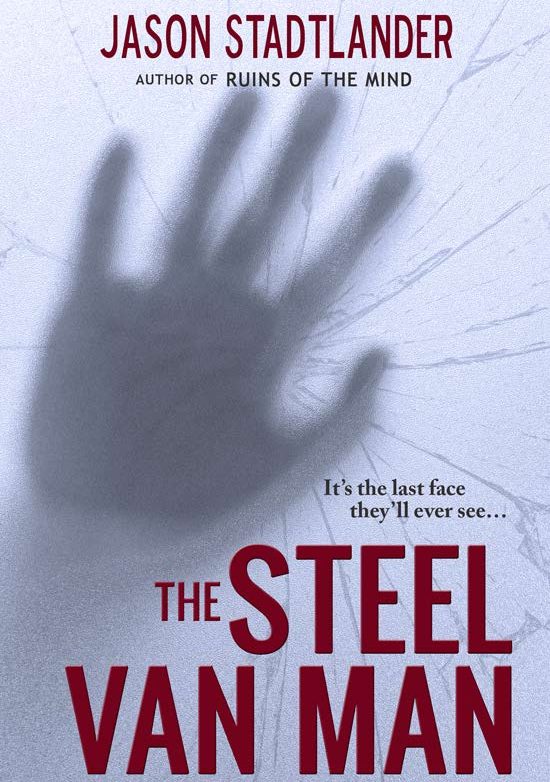 Thanks to the amazing crew at BHC Press, I have re-released The Steel Van Man.
Thanks to the amazing crew at BHC Press, I have re-released The Steel Van Man.
I wanted it to be a special release. I couldn’t see any point in just re-releasing the book without making it worthwhile. Several people have asked me what is new in the “new” The Steel Van Man, so I thought I’d take a moment and lay them out of I can without ruining the surprises. Aside from the obvious cover change, there are some other exciting pieces.
In the book:
- 2 new chapters:
- One focuses a little on Maggie (the reporter) researching her truths that she finds out about the killer.
- The other is a very special ending that reveals something about a character you may have come to love.
- Elements added about the killer’s mother
- Town changed from Mantaqua Point to Swampscott
Special added feature:
- 2 Chapters of the brand new sequel coming soon “The Father”
Some Skinny on The Father:
Let’s take a moment to talk about The Father. What is the book really about? Well, obviously I don’t want to spoil any surprises but I can tell you a few things about it.
- The book focuses on the intricacies of the killer’s family and a hidden family member that we never know about.
- A special character from the first book becomes a hero in ways we could never have dreamed
- Rebecca Lacitor continues to grapple with the secrets she’s forced to contain as it slowly eats away at her psyche.












 Saturday Morning Cartoons: In an age of Netflix, YouTube and Amazon Prime, today’s children will never know what it was like to have to “wait” until Saturday morning when you could finally watch what you wanted to watch (and adults had to endure the onslaught of children’s programming and commercials for toys galore). We all had our favorites such as
Saturday Morning Cartoons: In an age of Netflix, YouTube and Amazon Prime, today’s children will never know what it was like to have to “wait” until Saturday morning when you could finally watch what you wanted to watch (and adults had to endure the onslaught of children’s programming and commercials for toys galore). We all had our favorites such as  The Pet Rock: You can call Gary Ross Dahl crazy for inventing The Pet Rock, but you gotta give it to the guy, anyone who can come up with an idea of grabbing a bunch of rocks our of his back yard and get people to buy it can’t be that crazy given that he made $1.4 million on his short lived venture. Anyone want to buy a Blade of Grass for $1.50? I’ve got a couple million I’ll sell you!
The Pet Rock: You can call Gary Ross Dahl crazy for inventing The Pet Rock, but you gotta give it to the guy, anyone who can come up with an idea of grabbing a bunch of rocks our of his back yard and get people to buy it can’t be that crazy given that he made $1.4 million on his short lived venture. Anyone want to buy a Blade of Grass for $1.50? I’ve got a couple million I’ll sell you! The Pay Phone: “Here’s a quarter, call someone who cares.” You’re going to be late; you can’t find their house; you need to call home; you want some privacy from the house phone? No problem… use the payphone. A staple at almost every street corner up until the 1990s, the payphone was the best way to reach out and talk to someone. Once cell phones became mainstream, we no longer had a use for them.
The Pay Phone: “Here’s a quarter, call someone who cares.” You’re going to be late; you can’t find their house; you need to call home; you want some privacy from the house phone? No problem… use the payphone. A staple at almost every street corner up until the 1990s, the payphone was the best way to reach out and talk to someone. Once cell phones became mainstream, we no longer had a use for them. The Atari 2600: I wanted one starting around the age of 5 (I guess that dates me) and loved the idea of not having to go to an arcade to play a video game… but to actually be at home to play! Ted Dabney and Nolan Bushnell developed the Atari gaming system in the 1970s. Originally operating under the name “Syzygy”, Bushnell and Dabney changed the name of their company to “Atari” in 1972. Some of the more popular games for the system were
The Atari 2600: I wanted one starting around the age of 5 (I guess that dates me) and loved the idea of not having to go to an arcade to play a video game… but to actually be at home to play! Ted Dabney and Nolan Bushnell developed the Atari gaming system in the 1970s. Originally operating under the name “Syzygy”, Bushnell and Dabney changed the name of their company to “Atari” in 1972. Some of the more popular games for the system were  The Game Boy: Another product in the video game market. It was a handheld game console which was developed and manufactured by Nintendo and first released in the 100th anniversary of Nintendo in Japan on April 21, 1989. It shipped with Tetris as an included game, but you had to buy additional games if you wanted to play others. During its early lifetime, the Game Boy mainly competed with Sega’s Game Gear, Atari’s Lynx, and NEC’s TurboExpress. The Game Boy outsold its rivals and became a significant success.
The Game Boy: Another product in the video game market. It was a handheld game console which was developed and manufactured by Nintendo and first released in the 100th anniversary of Nintendo in Japan on April 21, 1989. It shipped with Tetris as an included game, but you had to buy additional games if you wanted to play others. During its early lifetime, the Game Boy mainly competed with Sega’s Game Gear, Atari’s Lynx, and NEC’s TurboExpress. The Game Boy outsold its rivals and became a significant success. Atlas: Atlases and road maps are rapidly disappearing with the GPS and the mapping technologies built into phones and tablets. Most of the time you don’t even need to enter an address in, you simply ask Google or Siri how to get somewhere and it automatically routes you. I challenge our youth to get us to the next state without an electronic device. Could they do it?
Atlas: Atlases and road maps are rapidly disappearing with the GPS and the mapping technologies built into phones and tablets. Most of the time you don’t even need to enter an address in, you simply ask Google or Siri how to get somewhere and it automatically routes you. I challenge our youth to get us to the next state without an electronic device. Could they do it? technology. To much of the world (yes they served not just USA), America Online (AOL) was one of the early pioneers offering home users the ability to connect to (what they believed was) the internet. I say it’s a joke, because the reality is, although you could browse the websites using america online – you were actually secluded most of the time to their private network which was based in Virginia. Their spin-off messaging application: AOL instant Messenger (AIM) was hugely popular from 1997 until around 2005.
technology. To much of the world (yes they served not just USA), America Online (AOL) was one of the early pioneers offering home users the ability to connect to (what they believed was) the internet. I say it’s a joke, because the reality is, although you could browse the websites using america online – you were actually secluded most of the time to their private network which was based in Virginia. Their spin-off messaging application: AOL instant Messenger (AIM) was hugely popular from 1997 until around 2005.